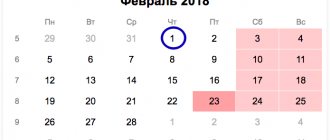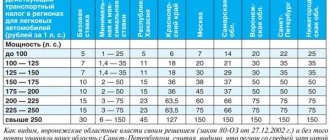Independent determination of the tax amount
Only legal entities independently calculate the amount of transport tax for themselves. If the owner of the car is an ordinary person, then the amount of transport tax payable for him is calculated by the tax authority. That is, individuals pay transport tax after receiving the relevant document from the Federal Tax Service inspection.
Also see “Transport tax for legal entities: KBK in 2021”.
Next, we will discuss in detail the methodology for determining the amount of tax by enterprises.
If an organization had an expensive vehicle registered in 2021, the accountant, when calculating the transport tax, is obliged to apply an increasing coefficient for the transport tax in 2017 - Kp. As a result, the total amount of tax according to the calculation method is determined for all machines separately.
There is a clear rule according to which the amount of the tax payment is the product of:
- tax base (taking into account the engine power of the car, usually in horsepower);
- tax rates;
- shared ownership of a car;
- coefficient Kv (the ratio of the number of months of owning a car in the reporting year to the number of calendar months in the taxation period (always 12 months))
- increasing coefficient Kp.
Also see “Rules, procedure and formulas for calculating transport tax in 2017”.
Transport tax in 2021
To date, only one innovation for 2017 is known for sure. It concerns freight transport: owners of vehicles weighing more than 12 tons can expect a tax reduction in the coming year. But the exact size of these benefits has not yet been announced.
In general, there have been no significant changes in the field of transport taxation. All previously existing benefits and the conditions for their accrual remain the same. You need to find out about available benefits at your place of residence (or car registration).
Increase in tax on luxury cars
Since 2014, to determine the amount of tax payment for transport, it is necessary to take into account the Kp coefficient. Using this instrument, the state applies increased taxation on luxury items.
But KP is not calculated for every vehicle registered with a company, but only in situations where the company owns a so-called luxury car.
What do you mean by luxury car? Legislatively, since 2016, cars with the appropriate engine capacity and price exceeding 3,000,000 rubles have been classified as luxury vehicles. At the same time, in addition to the original price at which the car was purchased, it is necessary to take into account the time that has elapsed since the car was manufactured.
According to information from reliable sources, a bill has already been prepared, according to which a vehicle costing over 5,000,000 rubles will be considered luxury.
An increasing transport tax coefficient is used in 2017 if the car meets the following conditions:
- price – not less than 3,000,000 rubles;
- the brand and model are mentioned in the list of the Ministry of Industry and Trade;
- no more years have passed since the date of manufacture of the car than indicated in the list of the Ministry of Industry and Trade.
How to calculate the cost of a car? Before other actions, you need to establish whether your vehicle is on the List of passenger cars with an average cost of 3,000,000 rubles for the tax period for 2021.
This List is prepared and posted on the website of the Ministry of Industry and Trade of Russia. The full list of cars subject to luxury tax in 2021 is published on our website at the following link.
Also, the current list of cars of the Ministry of Industry and Trade, prepared by it for the period 2021, can be viewed and downloaded on our website using the following link.
Please note that for the purposes of calculating transport tax, the list of cars with an increasing coefficient is regularly supplemented. Thus, in 2016, the list of the model range consisted of more than 700 types of cars, and for 2021 there are already more than 900 positions.
Also see “List of the Ministry of Industry and Trade of expensive cars in 2021.”
Kp coefficient (transport tax 2021 for legal entities)
When calculating transport tax, an increasing coefficient Kp is also applied, reflected on line 180 of the tax return with an accuracy of 1 decimal place (clause 5.16.1 of the Procedure, approved by Order of the Federal Tax Service dated December 5, 2016 No. ММВ-7-21 / [email protected] ).
So, for example, when calculating transport tax on passenger cars with an average cost of 3 million to 5 million rubles inclusive, an increasing coefficient is applied depending on the year of manufacture of the car (clause 2 of Article 362 of the Tax Code of the Russian Federation):
- 1.1, if 2 to 3 years have passed since the year of manufacture;
- 1.3, if 1 to 2 years have passed since the year of manufacture;
- 1.5, if no more than 1 year has passed since the year of manufacture.
And, say, the increasing coefficient for passenger cars with an average cost of 15 million rubles, the year of which no more than 20 years have passed, is 3.
Determining the operating time of a vehicle
In the List you can find references to the number of years from the date of manufacture of the machine (column No. 6). After the end of such a period, the vehicle, as it were, acquires the status of a “budget” car. That is, the Kp coefficient is no longer used when determining the amount of transport tax.
How to determine the period of operation of a vehicle? Thus, for the purposes of the Kp coefficient, which increases the amount of payment, the time from the moment of manufacture of the car is calculated taking into account the registered date of manufacture of the car (including it).
If it is necessary to apply a differentiated rate (clause 3 of Article 361 of the Tax Code of the Russian Federation), the lifetime of the machine is counted from the year following the date of manufacture of the vehicle. This rule does not apply to the application of the Kp coefficient.
EXAMPLE
When calculating transport tax using the increasing coefficient Kp for 2021 for a car priced from 3 to 5 million rubles, manufactured in 2014, the period that has passed since the production of this vehicle is 4 years. Taking into account the calculation methodology, from 2017 the Kp coefficient does not need to be applied to this vehicle.
Taking into account the above, when determining the time from the date of manufacture of the car, you need to end with the year for which the tax is applied. It is this approach that is confirmed by the explanations of the tax authorities, based on the Tax Code (letter of the Federal Tax Service dated March 2, 2015 No. BS-4-11/3274).
Also see “Kv coefficient in the declaration of legal entities for transport tax in 2017”.
Odds in Russian regions
Regions have the right to reduce or increase the base rate established by Art. 361 Tax Code of the Russian Federation. The table shows data for some Russian cities, in comparison with the federal standard.
| Region name | Rate for low-power vehicles (up to 100 hp) | For medium power cars (up to 150 hp) | For powerful vehicles (up to 200 hp) |
| Base rate | 2,5 | 3,5 | 5 |
| Orenburg | 15 | 30 | |
| Sverdlovsk | 2,5 | 9,4 | 32,7 |
| Kaliningrad | 2,5 | 15 | 35 |
| Tomsk | 5 | 8 | 20 |
| Krasnoyarsk | 5 | 14,5 | 29 |
| Karelia | 6 | 30 | 50 |
| Magadan | 6 | 8 | 12 |
| Omsk | 7 | 15 | 30 |
| Stavropol | 7 | 15 | 36 |
| Kemerovo | 8 | 14 | 45 |
| Volgograd | 9 | 20 | 40 |
| Kamchatka | 9 | 24 | 40 |
| Bryansk | 10 | 18 | 40 |
| Kaluga | 10 | 25 | 50 |
| Moscow and Moscow region | 12/10 | 35/34 | 50/49 |
| Pskov | 13 | 25 | 50 |
| Saratov | 14 | 30 | 50 |
| Penza | 15 | 30 | 45 |
| Samara | 16 | 20 | 45 |
| Primorsky Krai | 18 | 26 | 43 |
| Leningrad region. | 18 | 35 | 50 |
| Tambov | 20 | 30 | 50 |
| Saint Petersburg | 24 | 35 | 50 |
| Permian | 25 | 30 | 50 |
Each region approves a list of preferential categories of taxpayers for transport tax. In most regions the following are exempt from contributions to the budget:
- Heroes of the USSR and the Russian Federation;
- persons, 1st disability group;
- private farmers.
A 50% benefit is established for pensioners, disabled people of groups 2 and 3, large families, veterans and other socially vulnerable categories of the population. In some areas, individuals are completely exempt from transport tax.
If a citizen has a 100% benefit, the increasing factor does not apply.
If the car is not in the List
What should you do if the car on which you need to pay transport tax is not included in the document regulating the application of the increasing coefficient Kp? In this situation, you need to calculate the average cost of the vehicle yourself.
For correct calculation, the Russian Ministry of Industry and Trade has approved the Methodology for calculating the average cost of passenger cars. The option for determining it depends on the territorial location of the dealer or car manufacturer. That is, they take into account the stationary location of the point of sale of the car - on domestic territory or abroad:
- If the point of sale of the vehicle is located in Russia, the dealer/manufacturer provides information on the recommended retail selling prices of the vehicle.
- In the second case, data is taken from automobile catalogs - “Audatex”, “DAT”, “Kelley Blue Book”, “Mitchel”, “Motor”, “Canadien Black Book”, “Schwacke”.
Tax × 3
What should be done if the car is included in the List of transport tax vehicles with an increasing coefficient, costs more than 3,000,000 rubles and its operating time is longer than those established by the Tax Code of the Russian Federation and the List of the Ministry of Industry and Trade of standards for applying the increasing coefficient Kp?
In such a situation, the payment amount must be adjusted to a coefficient. There are 5 types in total. Each depends on the year the car was made and its price.
The minimum percentage increase in payment is 10. In the case of a maximum increase, the tax will triple (see table below).
| Year of manufacture of the car and transport tax | ||||||
| Car price (million rubles) | Coefficient based on the number of years from the year of manufacture of the passenger car | |||||
| Up to 1 year | From 1 to 2 years | From 2 to 3 years | Up to 5 years | Up to 10 years | Up to 20 years | |
| From 3 to 5 | 1.5 | 1.3 | 1.1 | |||
| From 5 to 10 | 2 | |||||
| From 10 to 15 | 3 | |||||
| From 15 | 3 | |||||
Kv coefficient (transport tax 2021 for legal entities)
The formula for calculating transport tax for legal entities, or rather the procedure for determining it, is contained in Art. 362 Tax Code of the Russian Federation. This procedure involves the use of various types of coefficients. One of them is the Kv coefficient, which shows how many full months in a calendar year the organization owned the vehicle. This coefficient is reflected on line 160 of the tax return for transport tax accurate to the 4th decimal place (clause 5.15 of the Procedure, approved by Order of the Federal Tax Service dated December 5, 2016 No. ММВ-7-21 / [email protected] ). For example, if an organization owned a vehicle for 5 months a year, the coefficient Kv, calculated as 5/12, should be reflected as follows: 0.4167 (5/12).
At the same time, the specifics of calculating the coefficient Kv in the case where the vehicle was registered with an organization or removed from it before the 15th day of the month or after this date are established in clause 3 of Art. 362 Tax Code of the Russian Federation.
Quarterly tax calculation
As a rule, enterprises are required to determine the transport tax every quarter, also applying the adjustment coefficient Kp.
For example, in 2014, the KP was applied exclusively to the annual amount of transport tax. All quarterly payments were calculated without applying a corrective increasing factor. But starting from 2015, it must also be used when calculating tax advances.
In the process of filling out the main transport tax report, the coefficient Kp is indicated in line 180 of Section 2. Its value is taken from the table we provided above.
Also see "Transport Tax: Advance Payments in 2021."
Read also
19.06.2017
Coefficient Kl (transport tax 2021 for legal entities)
The coefficient Kl when calculating transport tax is applied when using a tax incentive. In this case, the coefficient is determined as the ratio of the number of full months during which the tax benefit was provided to the number of calendar months in the year. The coefficient value is rounded to the 4th decimal place. And the coefficient itself is indicated on line 210 of the tax return (clause 5.19 of the Procedure, approved by Order of the Federal Tax Service dated December 5, 2016 No. ММВ-7-21 / [email protected] ).
Any person who owns a registered passenger car is required to regularly pay tax on their vehicle. Both individuals and legal entities are required to do this. Thus, the impact of the increasing transport tax coefficient in 2017 applies to any registered cars, no matter who owns them. This coefficient will be discussed in the article.









